Comprehensive Financial Analysis of TESCO Using Ratio Analysis
VerifiedAdded on 2023/06/18
|7
|2011
|352
Report
AI Summary
This report provides a comprehensive financial analysis of TESCO Plc from 2017 to 2020 using various accounting ratios to evaluate its performance, liquidity, and financial structure. The analysis covers profitability, operational efficiency, and structural stability, highlighting trends and areas for improvement. Key findings include fluctuating ROCE, increasing gross margins offset by high indirect expenses, inconsistent debtor days, and a declining current ratio. The report also addresses the limitations of ratio analysis, such as reliance on past data, changes in accounting practices, potential for financial statement manipulation, and the exclusion of qualitative factors. The analysis concludes that while TESCO's overall financial condition is reasonably stable, there are opportunities to enhance profitability, manage expenses, and improve liquidity.
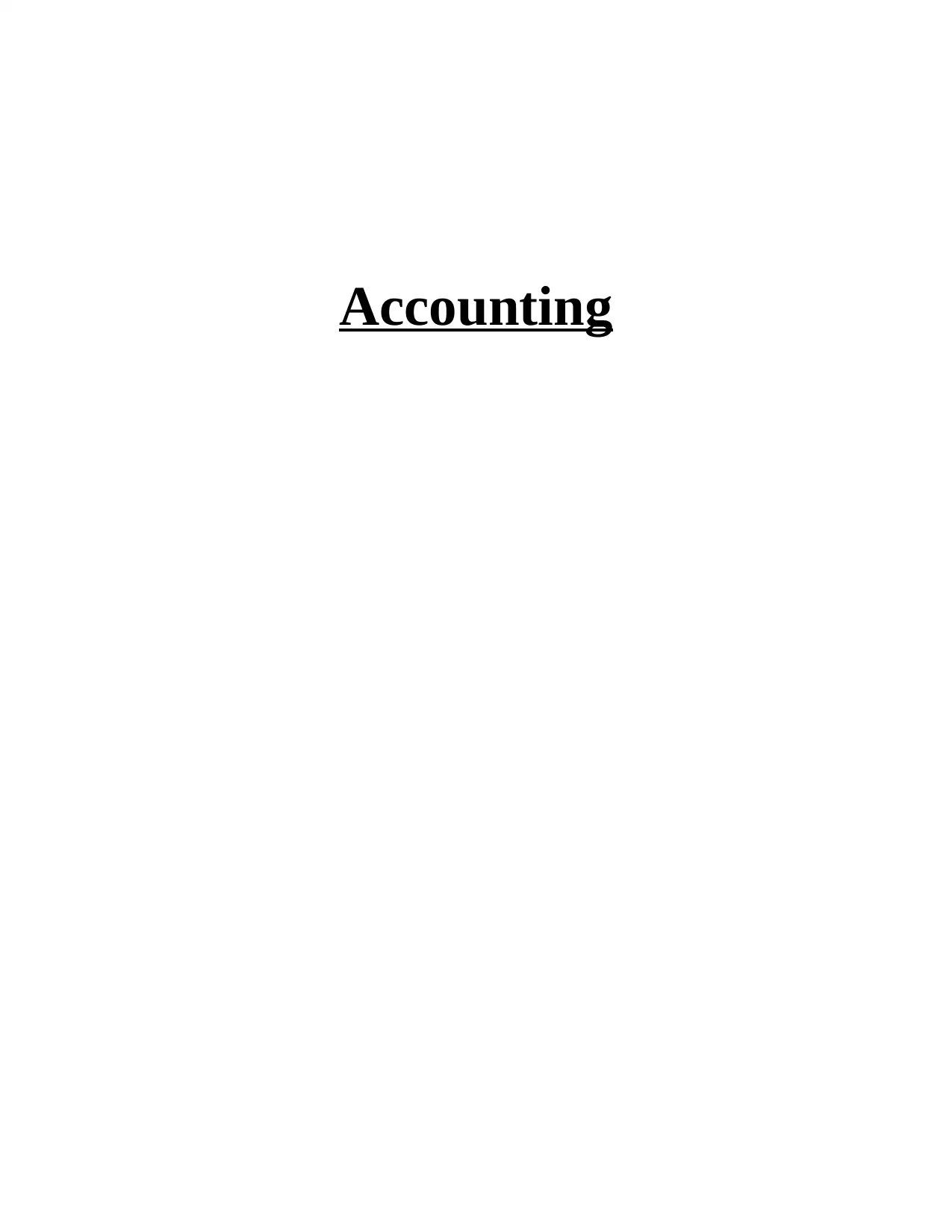
Accounting
Paraphrase This Document
Need a fresh take? Get an instant paraphrase of this document with our AI Paraphraser
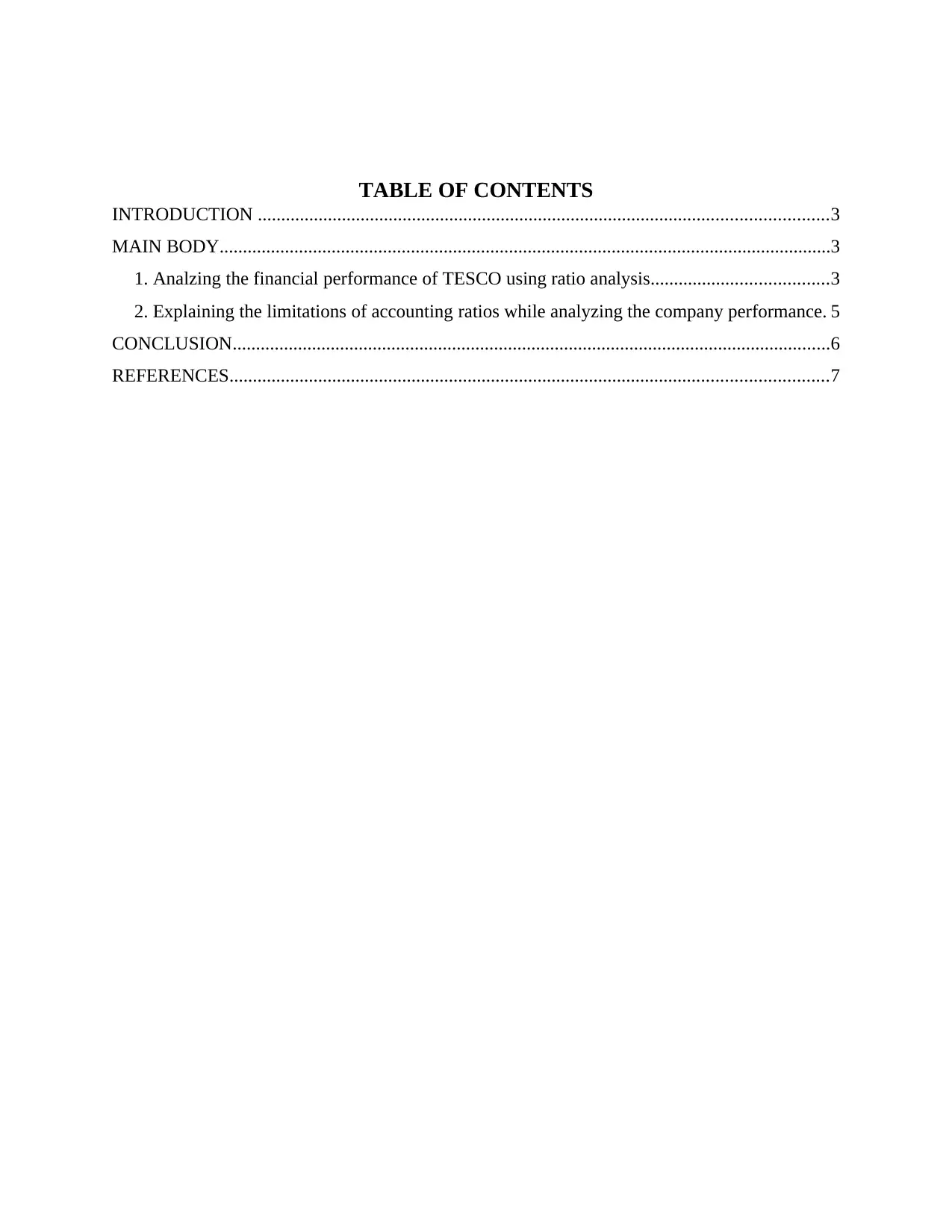
TABLE OF CONTENTS
INTRODUCTION ..........................................................................................................................3
MAIN BODY...................................................................................................................................3
1. Analzing the financial performance of TESCO using ratio analysis......................................3
2. Explaining the limitations of accounting ratios while analyzing the company performance. 5
CONCLUSION................................................................................................................................6
REFERENCES................................................................................................................................7
INTRODUCTION ..........................................................................................................................3
MAIN BODY...................................................................................................................................3
1. Analzing the financial performance of TESCO using ratio analysis......................................3
2. Explaining the limitations of accounting ratios while analyzing the company performance. 5
CONCLUSION................................................................................................................................6
REFERENCES................................................................................................................................7
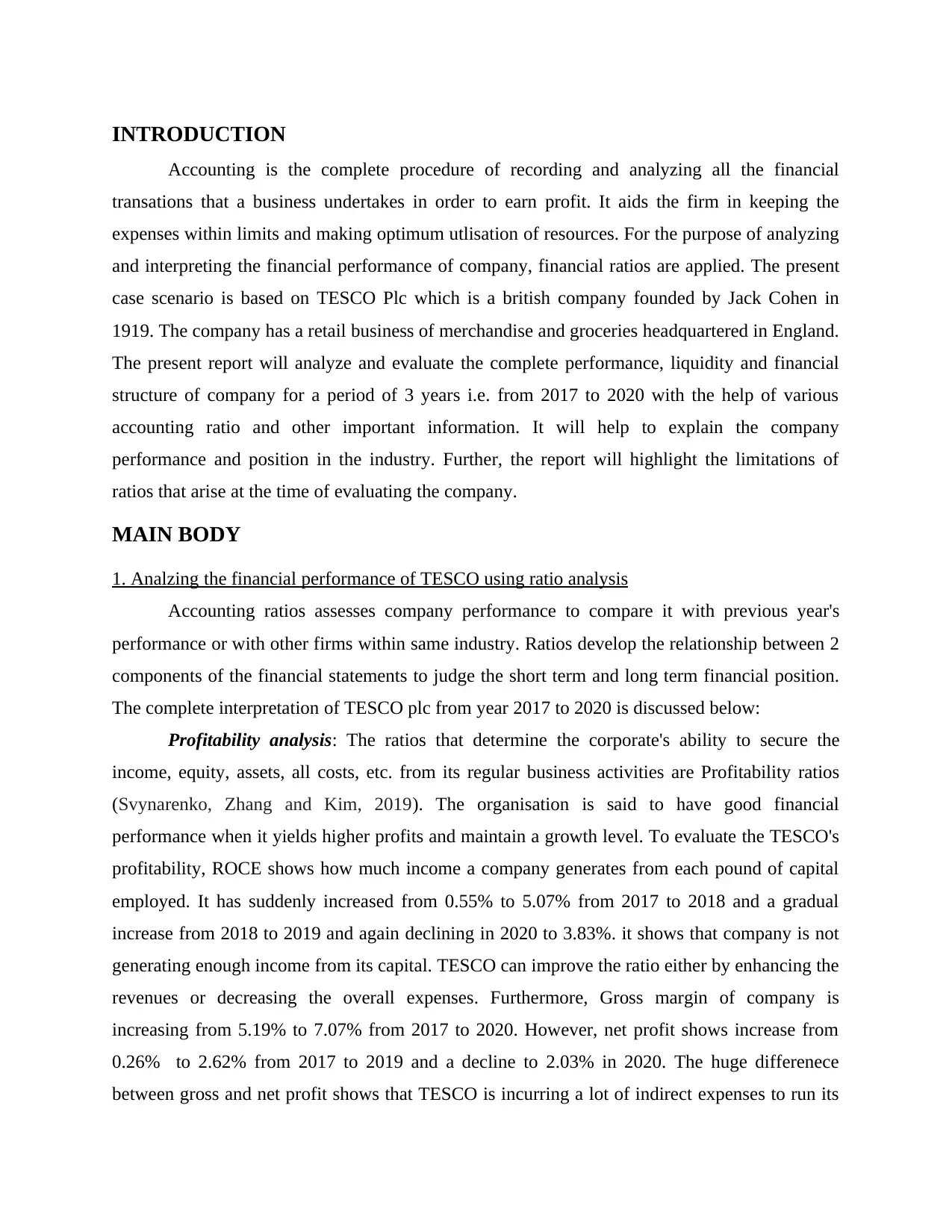
INTRODUCTION
Accounting is the complete procedure of recording and analyzing all the financial
transations that a business undertakes in order to earn profit. It aids the firm in keeping the
expenses within limits and making optimum utlisation of resources. For the purpose of analyzing
and interpreting the financial performance of company, financial ratios are applied. The present
case scenario is based on TESCO Plc which is a british company founded by Jack Cohen in
1919. The company has a retail business of merchandise and groceries headquartered in England.
The present report will analyze and evaluate the complete performance, liquidity and financial
structure of company for a period of 3 years i.e. from 2017 to 2020 with the help of various
accounting ratio and other important information. It will help to explain the company
performance and position in the industry. Further, the report will highlight the limitations of
ratios that arise at the time of evaluating the company.
MAIN BODY
1. Analzing the financial performance of TESCO using ratio analysis
Accounting ratios assesses company performance to compare it with previous year's
performance or with other firms within same industry. Ratios develop the relationship between 2
components of the financial statements to judge the short term and long term financial position.
The complete interpretation of TESCO plc from year 2017 to 2020 is discussed below:
Profitability analysis: The ratios that determine the corporate's ability to secure the
income, equity, assets, all costs, etc. from its regular business activities are Profitability ratios
(Svynarenko, Zhang and Kim, 2019). The organisation is said to have good financial
performance when it yields higher profits and maintain a growth level. To evaluate the TESCO's
profitability, ROCE shows how much income a company generates from each pound of capital
employed. It has suddenly increased from 0.55% to 5.07% from 2017 to 2018 and a gradual
increase from 2018 to 2019 and again declining in 2020 to 3.83%. it shows that company is not
generating enough income from its capital. TESCO can improve the ratio either by enhancing the
revenues or decreasing the overall expenses. Furthermore, Gross margin of company is
increasing from 5.19% to 7.07% from 2017 to 2020. However, net profit shows increase from
0.26% to 2.62% from 2017 to 2019 and a decline to 2.03% in 2020. The huge differenece
between gross and net profit shows that TESCO is incurring a lot of indirect expenses to run its
Accounting is the complete procedure of recording and analyzing all the financial
transations that a business undertakes in order to earn profit. It aids the firm in keeping the
expenses within limits and making optimum utlisation of resources. For the purpose of analyzing
and interpreting the financial performance of company, financial ratios are applied. The present
case scenario is based on TESCO Plc which is a british company founded by Jack Cohen in
1919. The company has a retail business of merchandise and groceries headquartered in England.
The present report will analyze and evaluate the complete performance, liquidity and financial
structure of company for a period of 3 years i.e. from 2017 to 2020 with the help of various
accounting ratio and other important information. It will help to explain the company
performance and position in the industry. Further, the report will highlight the limitations of
ratios that arise at the time of evaluating the company.
MAIN BODY
1. Analzing the financial performance of TESCO using ratio analysis
Accounting ratios assesses company performance to compare it with previous year's
performance or with other firms within same industry. Ratios develop the relationship between 2
components of the financial statements to judge the short term and long term financial position.
The complete interpretation of TESCO plc from year 2017 to 2020 is discussed below:
Profitability analysis: The ratios that determine the corporate's ability to secure the
income, equity, assets, all costs, etc. from its regular business activities are Profitability ratios
(Svynarenko, Zhang and Kim, 2019). The organisation is said to have good financial
performance when it yields higher profits and maintain a growth level. To evaluate the TESCO's
profitability, ROCE shows how much income a company generates from each pound of capital
employed. It has suddenly increased from 0.55% to 5.07% from 2017 to 2018 and a gradual
increase from 2018 to 2019 and again declining in 2020 to 3.83%. it shows that company is not
generating enough income from its capital. TESCO can improve the ratio either by enhancing the
revenues or decreasing the overall expenses. Furthermore, Gross margin of company is
increasing from 5.19% to 7.07% from 2017 to 2020. However, net profit shows increase from
0.26% to 2.62% from 2017 to 2019 and a decline to 2.03% in 2020. The huge differenece
between gross and net profit shows that TESCO is incurring a lot of indirect expenses to run its
⊘ This is a preview!⊘
Do you want full access?
Subscribe today to unlock all pages.

Trusted by 1+ million students worldwide
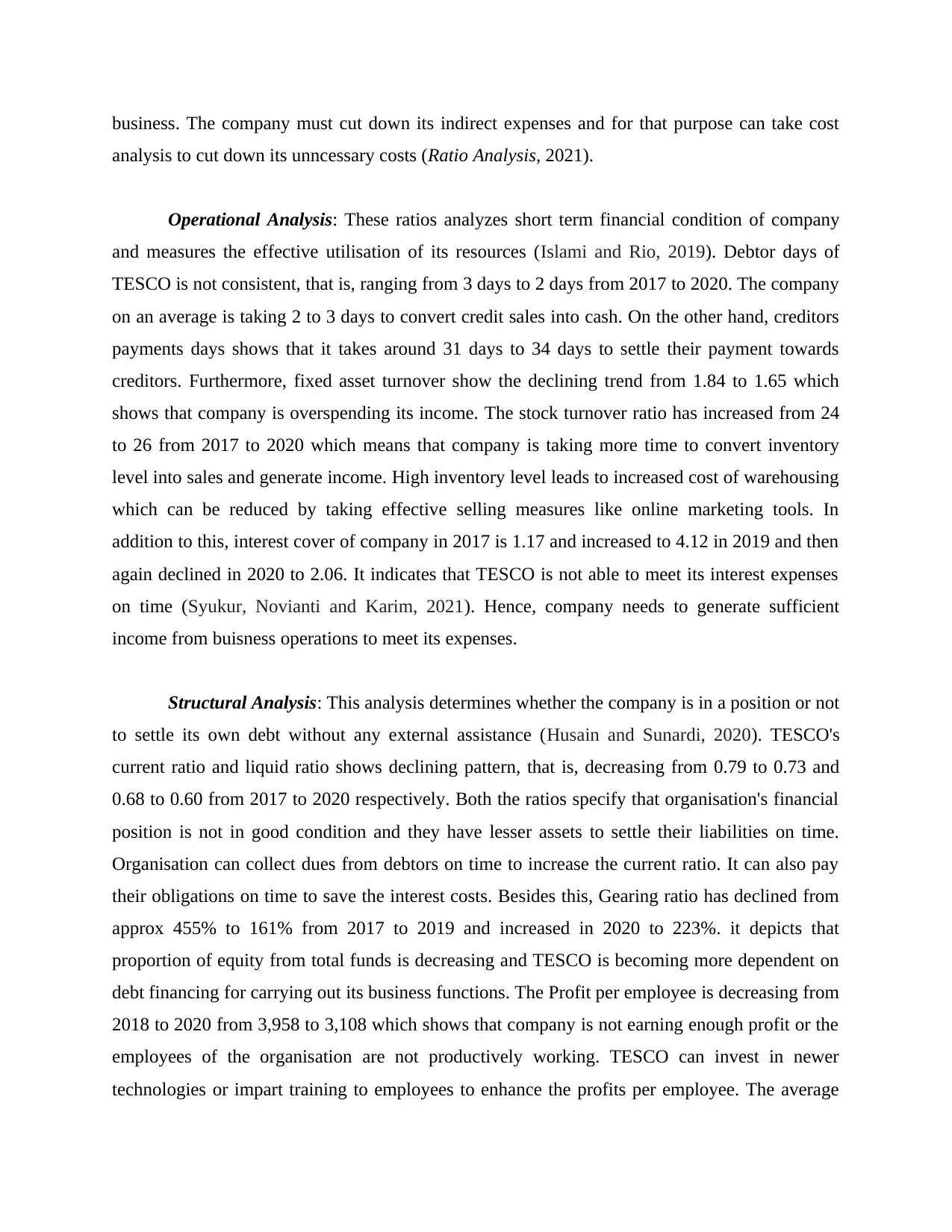
business. The company must cut down its indirect expenses and for that purpose can take cost
analysis to cut down its unncessary costs (Ratio Analysis, 2021).
Operational Analysis: These ratios analyzes short term financial condition of company
and measures the effective utilisation of its resources (Islami and Rio, 2019). Debtor days of
TESCO is not consistent, that is, ranging from 3 days to 2 days from 2017 to 2020. The company
on an average is taking 2 to 3 days to convert credit sales into cash. On the other hand, creditors
payments days shows that it takes around 31 days to 34 days to settle their payment towards
creditors. Furthermore, fixed asset turnover show the declining trend from 1.84 to 1.65 which
shows that company is overspending its income. The stock turnover ratio has increased from 24
to 26 from 2017 to 2020 which means that company is taking more time to convert inventory
level into sales and generate income. High inventory level leads to increased cost of warehousing
which can be reduced by taking effective selling measures like online marketing tools. In
addition to this, interest cover of company in 2017 is 1.17 and increased to 4.12 in 2019 and then
again declined in 2020 to 2.06. It indicates that TESCO is not able to meet its interest expenses
on time (Syukur, Novianti and Karim, 2021). Hence, company needs to generate sufficient
income from buisness operations to meet its expenses.
Structural Analysis: This analysis determines whether the company is in a position or not
to settle its own debt without any external assistance (Husain and Sunardi, 2020). TESCO's
current ratio and liquid ratio shows declining pattern, that is, decreasing from 0.79 to 0.73 and
0.68 to 0.60 from 2017 to 2020 respectively. Both the ratios specify that organisation's financial
position is not in good condition and they have lesser assets to settle their liabilities on time.
Organisation can collect dues from debtors on time to increase the current ratio. It can also pay
their obligations on time to save the interest costs. Besides this, Gearing ratio has declined from
approx 455% to 161% from 2017 to 2019 and increased in 2020 to 223%. it depicts that
proportion of equity from total funds is decreasing and TESCO is becoming more dependent on
debt financing for carrying out its business functions. The Profit per employee is decreasing from
2018 to 2020 from 3,958 to 3,108 which shows that company is not earning enough profit or the
employees of the organisation are not productively working. TESCO can invest in newer
technologies or impart training to employees to enhance the profits per employee. The average
analysis to cut down its unncessary costs (Ratio Analysis, 2021).
Operational Analysis: These ratios analyzes short term financial condition of company
and measures the effective utilisation of its resources (Islami and Rio, 2019). Debtor days of
TESCO is not consistent, that is, ranging from 3 days to 2 days from 2017 to 2020. The company
on an average is taking 2 to 3 days to convert credit sales into cash. On the other hand, creditors
payments days shows that it takes around 31 days to 34 days to settle their payment towards
creditors. Furthermore, fixed asset turnover show the declining trend from 1.84 to 1.65 which
shows that company is overspending its income. The stock turnover ratio has increased from 24
to 26 from 2017 to 2020 which means that company is taking more time to convert inventory
level into sales and generate income. High inventory level leads to increased cost of warehousing
which can be reduced by taking effective selling measures like online marketing tools. In
addition to this, interest cover of company in 2017 is 1.17 and increased to 4.12 in 2019 and then
again declined in 2020 to 2.06. It indicates that TESCO is not able to meet its interest expenses
on time (Syukur, Novianti and Karim, 2021). Hence, company needs to generate sufficient
income from buisness operations to meet its expenses.
Structural Analysis: This analysis determines whether the company is in a position or not
to settle its own debt without any external assistance (Husain and Sunardi, 2020). TESCO's
current ratio and liquid ratio shows declining pattern, that is, decreasing from 0.79 to 0.73 and
0.68 to 0.60 from 2017 to 2020 respectively. Both the ratios specify that organisation's financial
position is not in good condition and they have lesser assets to settle their liabilities on time.
Organisation can collect dues from debtors on time to increase the current ratio. It can also pay
their obligations on time to save the interest costs. Besides this, Gearing ratio has declined from
approx 455% to 161% from 2017 to 2019 and increased in 2020 to 223%. it depicts that
proportion of equity from total funds is decreasing and TESCO is becoming more dependent on
debt financing for carrying out its business functions. The Profit per employee is decreasing from
2018 to 2020 from 3,958 to 3,108 which shows that company is not earning enough profit or the
employees of the organisation are not productively working. TESCO can invest in newer
technologies or impart training to employees to enhance the profits per employee. The average
Paraphrase This Document
Need a fresh take? Get an instant paraphrase of this document with our AI Paraphraser
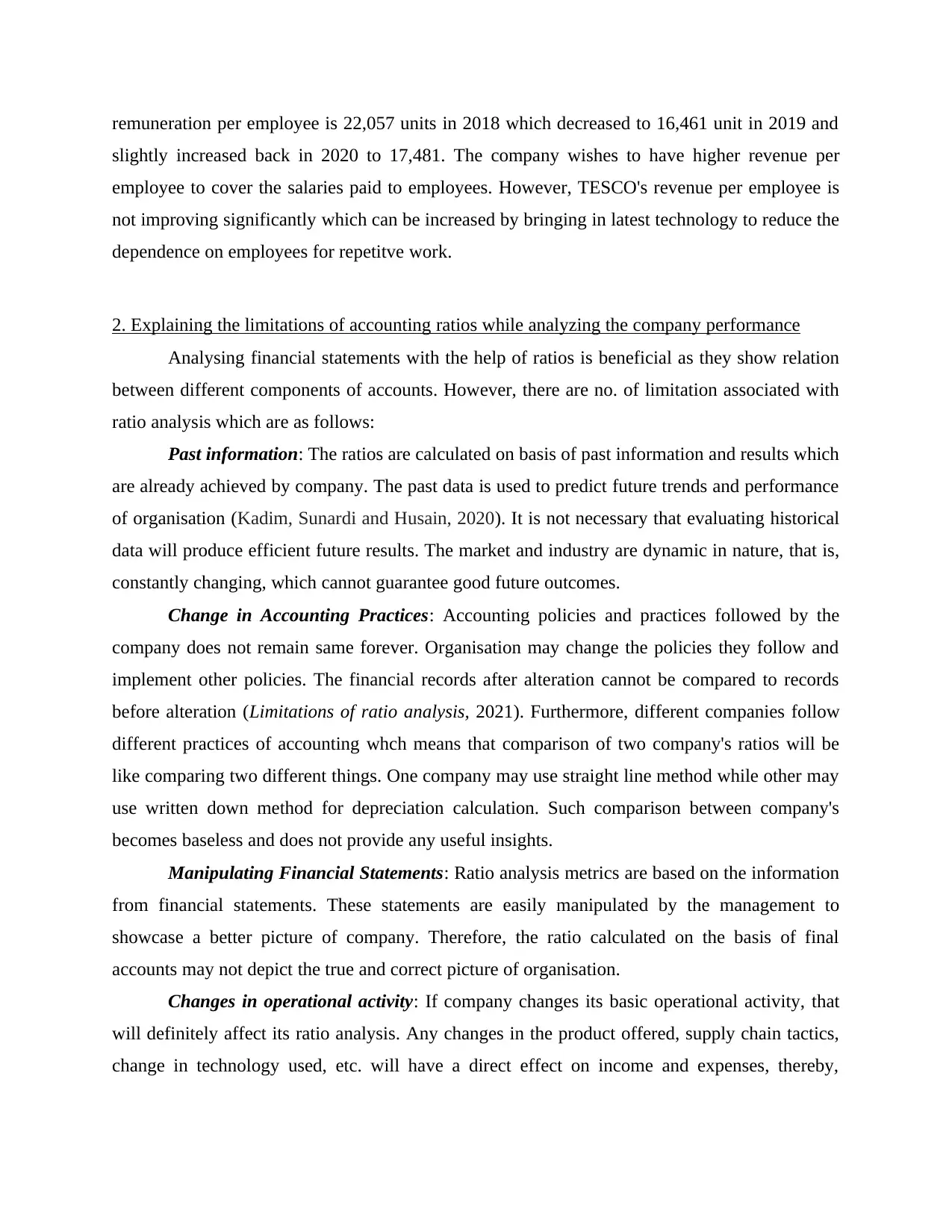
remuneration per employee is 22,057 units in 2018 which decreased to 16,461 unit in 2019 and
slightly increased back in 2020 to 17,481. The company wishes to have higher revenue per
employee to cover the salaries paid to employees. However, TESCO's revenue per employee is
not improving significantly which can be increased by bringing in latest technology to reduce the
dependence on employees for repetitve work.
2. Explaining the limitations of accounting ratios while analyzing the company performance
Analysing financial statements with the help of ratios is beneficial as they show relation
between different components of accounts. However, there are no. of limitation associated with
ratio analysis which are as follows:
Past information: The ratios are calculated on basis of past information and results which
are already achieved by company. The past data is used to predict future trends and performance
of organisation (Kadim, Sunardi and Husain, 2020). It is not necessary that evaluating historical
data will produce efficient future results. The market and industry are dynamic in nature, that is,
constantly changing, which cannot guarantee good future outcomes.
Change in Accounting Practices: Accounting policies and practices followed by the
company does not remain same forever. Organisation may change the policies they follow and
implement other policies. The financial records after alteration cannot be compared to records
before alteration (Limitations of ratio analysis, 2021). Furthermore, different companies follow
different practices of accounting whch means that comparison of two company's ratios will be
like comparing two different things. One company may use straight line method while other may
use written down method for depreciation calculation. Such comparison between company's
becomes baseless and does not provide any useful insights.
Manipulating Financial Statements: Ratio analysis metrics are based on the information
from financial statements. These statements are easily manipulated by the management to
showcase a better picture of company. Therefore, the ratio calculated on the basis of final
accounts may not depict the true and correct picture of organisation.
Changes in operational activity: If company changes its basic operational activity, that
will definitely affect its ratio analysis. Any changes in the product offered, supply chain tactics,
change in technology used, etc. will have a direct effect on income and expenses, thereby,
slightly increased back in 2020 to 17,481. The company wishes to have higher revenue per
employee to cover the salaries paid to employees. However, TESCO's revenue per employee is
not improving significantly which can be increased by bringing in latest technology to reduce the
dependence on employees for repetitve work.
2. Explaining the limitations of accounting ratios while analyzing the company performance
Analysing financial statements with the help of ratios is beneficial as they show relation
between different components of accounts. However, there are no. of limitation associated with
ratio analysis which are as follows:
Past information: The ratios are calculated on basis of past information and results which
are already achieved by company. The past data is used to predict future trends and performance
of organisation (Kadim, Sunardi and Husain, 2020). It is not necessary that evaluating historical
data will produce efficient future results. The market and industry are dynamic in nature, that is,
constantly changing, which cannot guarantee good future outcomes.
Change in Accounting Practices: Accounting policies and practices followed by the
company does not remain same forever. Organisation may change the policies they follow and
implement other policies. The financial records after alteration cannot be compared to records
before alteration (Limitations of ratio analysis, 2021). Furthermore, different companies follow
different practices of accounting whch means that comparison of two company's ratios will be
like comparing two different things. One company may use straight line method while other may
use written down method for depreciation calculation. Such comparison between company's
becomes baseless and does not provide any useful insights.
Manipulating Financial Statements: Ratio analysis metrics are based on the information
from financial statements. These statements are easily manipulated by the management to
showcase a better picture of company. Therefore, the ratio calculated on the basis of final
accounts may not depict the true and correct picture of organisation.
Changes in operational activity: If company changes its basic operational activity, that
will definitely affect its ratio analysis. Any changes in the product offered, supply chain tactics,
change in technology used, etc. will have a direct effect on income and expenses, thereby,
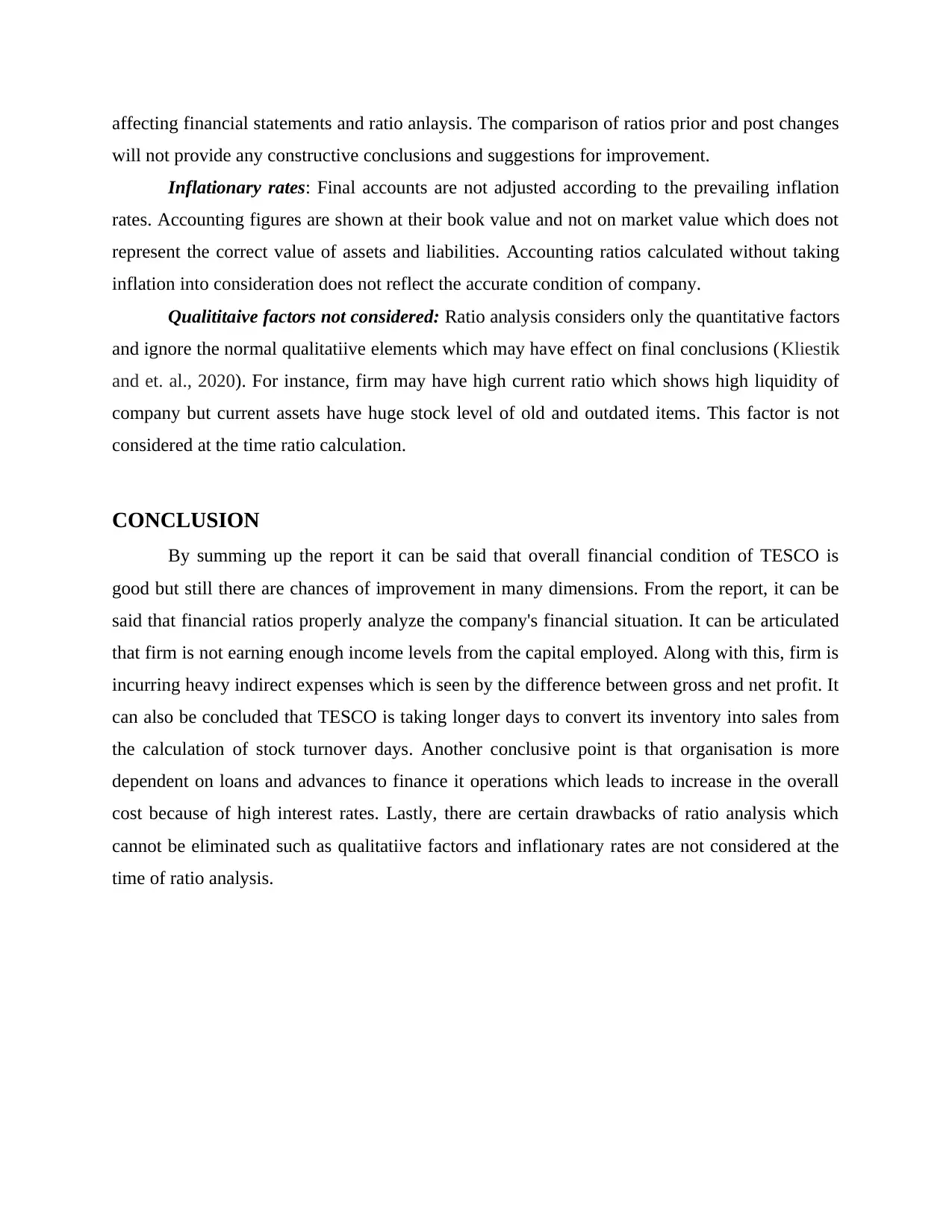
affecting financial statements and ratio anlaysis. The comparison of ratios prior and post changes
will not provide any constructive conclusions and suggestions for improvement.
Inflationary rates: Final accounts are not adjusted according to the prevailing inflation
rates. Accounting figures are shown at their book value and not on market value which does not
represent the correct value of assets and liabilities. Accounting ratios calculated without taking
inflation into consideration does not reflect the accurate condition of company.
Qualititaive factors not considered: Ratio analysis considers only the quantitative factors
and ignore the normal qualitatiive elements which may have effect on final conclusions (Kliestik
and et. al., 2020). For instance, firm may have high current ratio which shows high liquidity of
company but current assets have huge stock level of old and outdated items. This factor is not
considered at the time ratio calculation.
CONCLUSION
By summing up the report it can be said that overall financial condition of TESCO is
good but still there are chances of improvement in many dimensions. From the report, it can be
said that financial ratios properly analyze the company's financial situation. It can be articulated
that firm is not earning enough income levels from the capital employed. Along with this, firm is
incurring heavy indirect expenses which is seen by the difference between gross and net profit. It
can also be concluded that TESCO is taking longer days to convert its inventory into sales from
the calculation of stock turnover days. Another conclusive point is that organisation is more
dependent on loans and advances to finance it operations which leads to increase in the overall
cost because of high interest rates. Lastly, there are certain drawbacks of ratio analysis which
cannot be eliminated such as qualitatiive factors and inflationary rates are not considered at the
time of ratio analysis.
will not provide any constructive conclusions and suggestions for improvement.
Inflationary rates: Final accounts are not adjusted according to the prevailing inflation
rates. Accounting figures are shown at their book value and not on market value which does not
represent the correct value of assets and liabilities. Accounting ratios calculated without taking
inflation into consideration does not reflect the accurate condition of company.
Qualititaive factors not considered: Ratio analysis considers only the quantitative factors
and ignore the normal qualitatiive elements which may have effect on final conclusions (Kliestik
and et. al., 2020). For instance, firm may have high current ratio which shows high liquidity of
company but current assets have huge stock level of old and outdated items. This factor is not
considered at the time ratio calculation.
CONCLUSION
By summing up the report it can be said that overall financial condition of TESCO is
good but still there are chances of improvement in many dimensions. From the report, it can be
said that financial ratios properly analyze the company's financial situation. It can be articulated
that firm is not earning enough income levels from the capital employed. Along with this, firm is
incurring heavy indirect expenses which is seen by the difference between gross and net profit. It
can also be concluded that TESCO is taking longer days to convert its inventory into sales from
the calculation of stock turnover days. Another conclusive point is that organisation is more
dependent on loans and advances to finance it operations which leads to increase in the overall
cost because of high interest rates. Lastly, there are certain drawbacks of ratio analysis which
cannot be eliminated such as qualitatiive factors and inflationary rates are not considered at the
time of ratio analysis.
⊘ This is a preview!⊘
Do you want full access?
Subscribe today to unlock all pages.

Trusted by 1+ million students worldwide
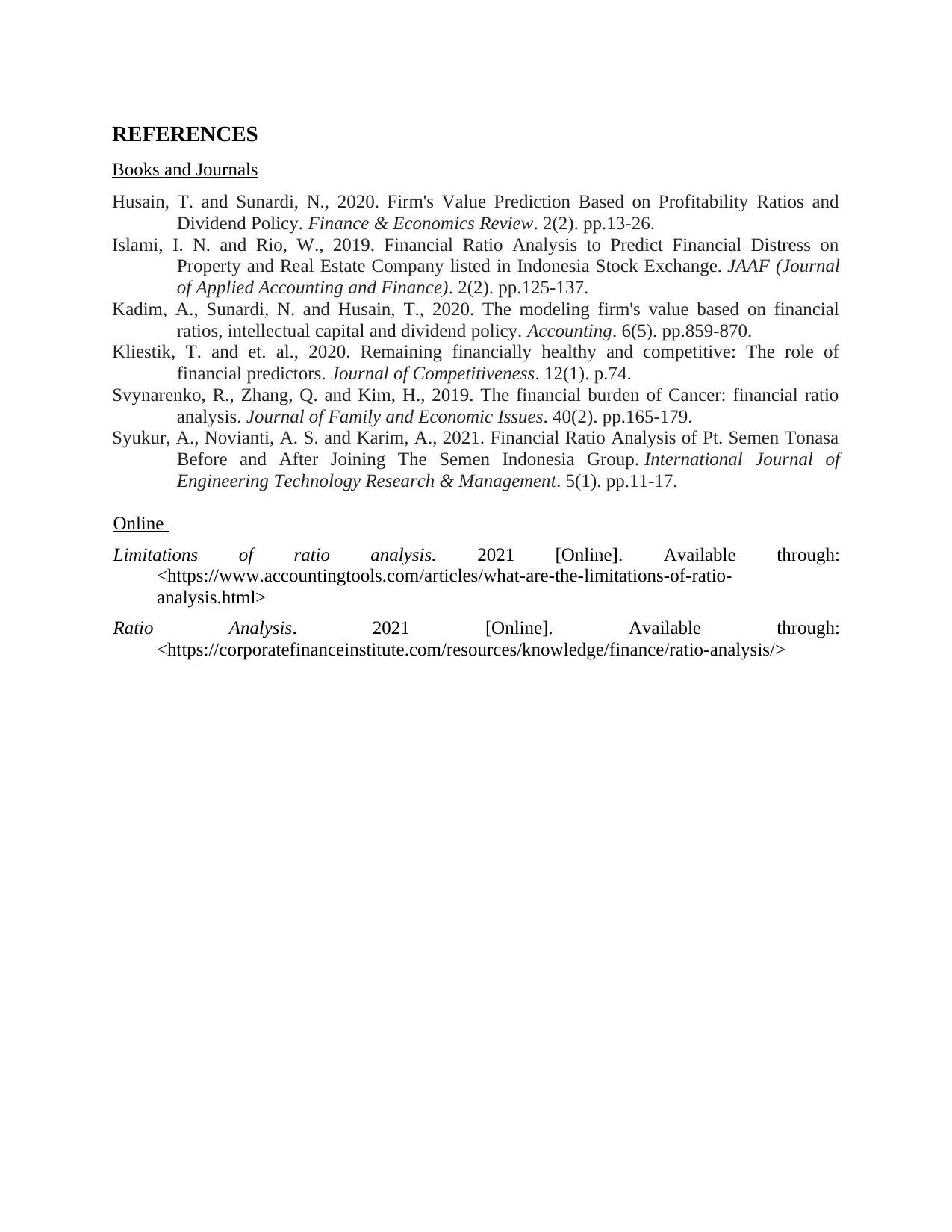
REFERENCES
Books and Journals
Husain, T. and Sunardi, N., 2020. Firm's Value Prediction Based on Profitability Ratios and
Dividend Policy. Finance & Economics Review. 2(2). pp.13-26.
Islami, I. N. and Rio, W., 2019. Financial Ratio Analysis to Predict Financial Distress on
Property and Real Estate Company listed in Indonesia Stock Exchange. JAAF (Journal
of Applied Accounting and Finance). 2(2). pp.125-137.
Kadim, A., Sunardi, N. and Husain, T., 2020. The modeling firm's value based on financial
ratios, intellectual capital and dividend policy. Accounting. 6(5). pp.859-870.
Kliestik, T. and et. al., 2020. Remaining financially healthy and competitive: The role of
financial predictors. Journal of Competitiveness. 12(1). p.74.
Svynarenko, R., Zhang, Q. and Kim, H., 2019. The financial burden of Cancer: financial ratio
analysis. Journal of Family and Economic Issues. 40(2). pp.165-179.
Syukur, A., Novianti, A. S. and Karim, A., 2021. Financial Ratio Analysis of Pt. Semen Tonasa
Before and After Joining The Semen Indonesia Group. International Journal of
Engineering Technology Research & Management. 5(1). pp.11-17.
Online
Limitations of ratio analysis. 2021 [Online]. Available through:
<https://www.accountingtools.com/articles/what-are-the-limitations-of-ratio-
analysis.html>
Ratio Analysis. 2021 [Online]. Available through:
<https://corporatefinanceinstitute.com/resources/knowledge/finance/ratio-analysis/>
Books and Journals
Husain, T. and Sunardi, N., 2020. Firm's Value Prediction Based on Profitability Ratios and
Dividend Policy. Finance & Economics Review. 2(2). pp.13-26.
Islami, I. N. and Rio, W., 2019. Financial Ratio Analysis to Predict Financial Distress on
Property and Real Estate Company listed in Indonesia Stock Exchange. JAAF (Journal
of Applied Accounting and Finance). 2(2). pp.125-137.
Kadim, A., Sunardi, N. and Husain, T., 2020. The modeling firm's value based on financial
ratios, intellectual capital and dividend policy. Accounting. 6(5). pp.859-870.
Kliestik, T. and et. al., 2020. Remaining financially healthy and competitive: The role of
financial predictors. Journal of Competitiveness. 12(1). p.74.
Svynarenko, R., Zhang, Q. and Kim, H., 2019. The financial burden of Cancer: financial ratio
analysis. Journal of Family and Economic Issues. 40(2). pp.165-179.
Syukur, A., Novianti, A. S. and Karim, A., 2021. Financial Ratio Analysis of Pt. Semen Tonasa
Before and After Joining The Semen Indonesia Group. International Journal of
Engineering Technology Research & Management. 5(1). pp.11-17.
Online
Limitations of ratio analysis. 2021 [Online]. Available through:
<https://www.accountingtools.com/articles/what-are-the-limitations-of-ratio-
analysis.html>
Ratio Analysis. 2021 [Online]. Available through:
<https://corporatefinanceinstitute.com/resources/knowledge/finance/ratio-analysis/>
1 out of 7
Related Documents
Your All-in-One AI-Powered Toolkit for Academic Success.
+13062052269
info@desklib.com
Available 24*7 on WhatsApp / Email
![[object Object]](/_next/static/media/star-bottom.7253800d.svg)
Unlock your academic potential
Copyright © 2020–2025 A2Z Services. All Rights Reserved. Developed and managed by ZUCOL.





